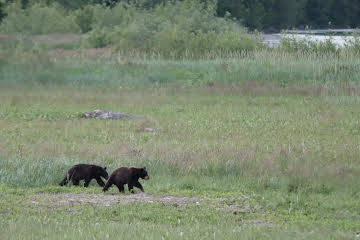With an increase in the abundance of natural foods this summer, bears in the area are likely to prefer salmonberrie over trash, according to willdlife experts.
“As we move through the summer this year, I think bears are going to be OK,” said Abby McAllister, wildlife education and outreach specialist with the Alaska Department of Fish and Game.
McAllister said July is usually the “make or break” month for bear activity and when it becomes clear if there will be enough natural food to attract bears to those resources and away from human-populated areas. This year’s “fantastically warm” conditions have brought a healthy crop of berries and other natural vegetation, which is allowing bears to forage on what they naturally should be eating she said. This comes after two years of increased bear encounters in the Juneau area that necessitated multiple euthanizations because of safety concerns.
Typically, most bears prefer to spend their time eating in a quiet berry patch away from people McAllister said. However, in the past few years, cooler weather caused a lackluster amount of food to forage and prompted many bears to make their way into more human-populated areas in search of food.
“Bears are truly opportunistic omnivores,” she said. “They’ll take food wherever they can find it, their main job really revolves around food and getting enough fat to weather a hibernation period.”
[4 bears killed in Anchorage campground reserved for homeless]
She said that although there are more natural foods this year, that doesn’t mean all bears will take that opportunity. Some bears near more populated areas have been conditioned to seek food from garbages or near human-populated areas — after being taught by their mom or out of the necessity of the past — which can lead to activity persisting near populated areas.
Another reason it might look like your garbage bin got into a street fight could likely be because of a yearling bear — a bear recently “kicked loose” by its mom — who is trying to figure out where and how to get food now that they’re on their own.
“They’re basically like a teenager,” McAllister said. “They’re just trying to find their way in the world and can often get into trouble on the way trying to figure out the do’s and don’ts of bear life.”
She said it’s not something that people need to be extremely nervous about, but to be aware of and make sure to make loud noises to let them know your garbage is not a good place to be chowing down.
And Alaska Department of Fish and Game Juneau area biologist Roy Churchwell agrees.
“It’s been, knock on wood, relatively quiet for us this year,” he said. He also attributes this summer’s “decent green up” as the reason for the relative calmer bear activity in the area. He said this trend would likely continue into the rest of the summer provided that the berry and salmon runs remain adequate.
He still reiterates to “always be aware,” among other things like properly disposing of trash and alerting officials if you see a bear in your area.
[Reminder: Garbage cans can only be put on curb after 4 a.m. on pickup day]
“Make sure you take down your bird feeders and secure your trash and any attractions that could draw bears in,” he said.
• Contact reporter Clarise Larson at clarise.larson@juneauempire.com or at (651)-528-1807. Follow her on Twitter @clariselarson

